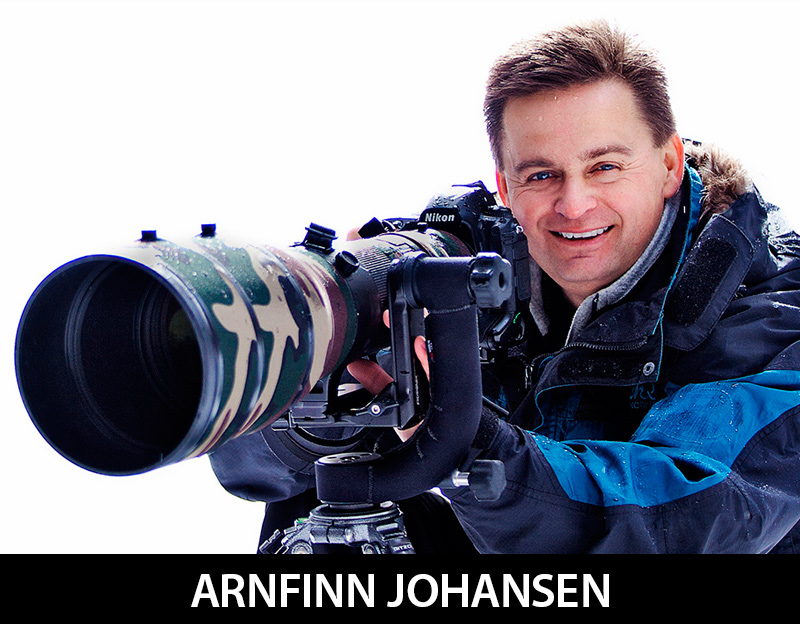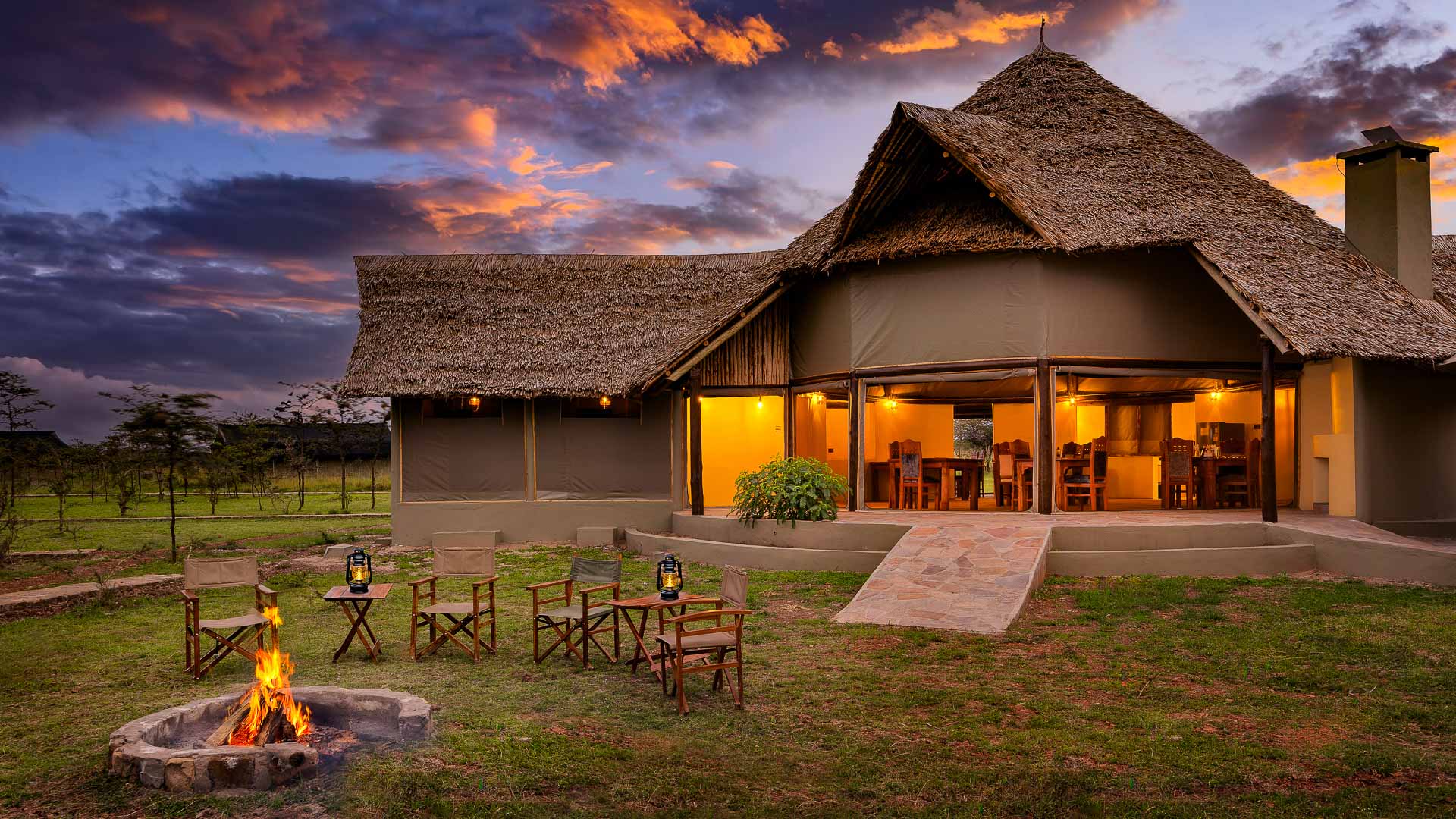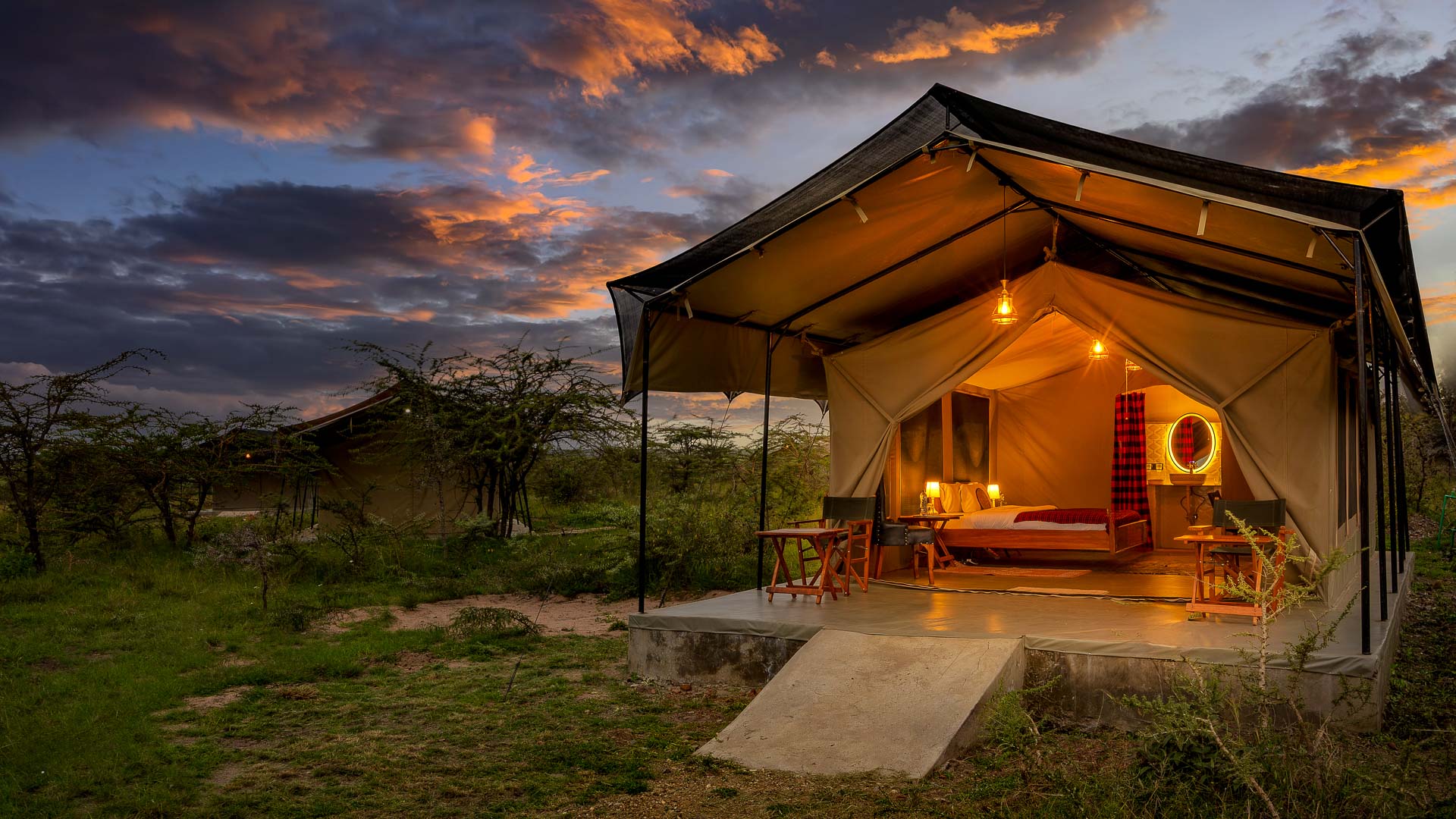COUNTRY: Kenya PHOTO: Wildlife DURATION: 7 days DATE: July 25-31 2027 PARTICIPANTS: 7-8
Join me on an exclusive journey to the Masai Mara and the Great Migration, where you’ll photograph the incredible wildlife from specially designed photo jeeps – and have the chance to capture the spectacular river crossings.
Arnfinn Johansen
The Great Migration in Masai Mara is one of nature’s most dramatic and awe-inspiring spectacles – a must for anyone who loves wildlife and photography.
Every year during July and August, the savannah transforms into a pulsating stage as millions of wildebeest and zebras embark on their ancient journey in search of fresh grazing grounds. But to reach the greener pastures, they must cross the feared Mara River – a treacherous stretch teeming with danger.
On one side of the river, thousands of animals gather, nervously waiting at the water’s edge. The tension is palpable. Suddenly, a few brave individuals plunge into the river – and in the next instant, chaos erupts. The landscape explodes in motion as thousands of animals throw themselves into the water, while crocodiles and hippos lie in wait beneath the surface.
It’s raw, untamed nature – right before your eyes, and through your camera lens.
At the end of July 2027, you have the chance to witness this natural wonder up close – and photograph it under the guidance of award-winning wildlife photographer Arnfinn Johansen.
Throughout the journey, we’ll explore the unique wildlife of Masai Mara in privately chartered, custom-built photojeeps, giving you the freedom to shoot from entirely new and creative angles. This is a trip designed by photographers – for photographers. To make the most of every moment on the savannah, we bring both breakfast and lunch with us, allowing us to stay out on safari from sunrise to sunset – up to 12–13 hours each day. You won’t miss a single moment, not a single ray of golden light, or the slightest movement in the tall grass.
If you want to experience the Great Migration like few others – with your camera in hand and unfolding before you – then this is the photo trip for you.

TOUR HIGHLIGHTS:
- The incredible wildlife of the Masai Mara
- The Great Migration
- Hundreds of thousands of wildebeest and zebras
- Spectacular river crossings
- The chance to photograph the Big Five
- Custom-built photo jeeps offering unique shooting angles
- Full-day safaris from sunrise to sunset
- Opportunity to photograph wildlife at eye level
- Great chances to capture hunting predators
- Full participation of Arnfinn Johansen throughout the trip
- Personal photo guidance by Arnfinn Johansen
COUNTRY: Kenya PHOTO: Wildlife DURATION: 7 days DATE: July 25-31 2027 PARTICIPANTS: 7-8
THE GREAT MIGRATION
WITH PHOTOGRAPHER ARNFINN JOHANSEN
Join me on an exclusive journey to the Masai Mara and the Great Migration, where you’ll photograph the incredible wildlife from specially designed photo jeeps – and have the chance to capture the spectacular river crossings.
Arnfinn Johansen
The Great Migration in Masai Mara is one of nature’s most dramatic and awe-inspiring spectacles – a must for anyone who loves wildlife and photography.
Every year during July and August, the savannah transforms into a pulsating stage as millions of wildebeest and zebras embark on their ancient journey in search of fresh grazing grounds. But to reach the greener pastures, they must cross the feared Mara River – a treacherous stretch teeming with danger.
On one side of the river, thousands of animals gather, nervously waiting at the water’s edge. The tension is palpable. Suddenly, a few brave individuals plunge into the river – and in the next instant, chaos erupts. The landscape explodes in motion as thousands of animals throw themselves into the water, while crocodiles and hippos lie in wait beneath the surface.
It’s raw, untamed nature – right before your eyes, and through your camera lens.
At the end of July 2027, you have the chance to witness this natural wonder up close – and photograph it under the guidance of award-winning wildlife photographer Arnfinn Johansen.
Throughout the journey, we’ll explore the unique wildlife of Masai Mara in privately chartered, custom-built photojeeps, giving you the freedom to shoot from entirely new and creative angles. This is a trip designed by photographers – for photographers. To make the most of every moment on the savannah, we bring both breakfast and lunch with us, allowing us to stay out on safari from sunrise to sunset – up to 12–13 hours each day. You won’t miss a single moment, not a single ray of golden light, or the slightest movement in the tall grass.
If you want to experience the Great Migration like few others – with your camera in hand and unfolding before you – then this is the photo trip for you.

TOUR HIGHLIGHTS:
- The incredible wildlife of the Masai Mara
- The Great Migration
- Hundreds of thousands of wildebeest and zebras
- Spectacular river crossings
- The chance to photograph the Big Five
- Custom-built photo jeeps offering unique shooting angles
- Full-day safaris from sunrise to sunset
- Opportunity to photograph wildlife at eye level
- Great chances to capture hunting predators
- Full participation of Arnfinn Johansen throughout the trip
- Personal photo guidance by Arnfinn Johansen
MASAI MARA
MASAI MARA
Masai Mara, Kenya’s most famous national park, is located in the southwestern part of the country and is commonly referred to simply as “the Mara.” This vast and stunningly beautiful park continues across the border into neighboring Tanzania, where it takes on a new name: the Serengeti. Approximately 10% of the ecosystem lies within Kenya, while the remaining 90% is situated in Tanzania. Masai Mara is largely composed of open landscapes and expansive grasslands. Two rivers, the Mara River and the Talek River, flow through the park and shape its scenery. It is along various points of the Mara River that millions of wildebeest and zebras make their dramatic river crossings each year during what is known as The Great Migration. Every year, massive herds of wildebeest and zebras arrive from the Serengeti to graze in the Mara for a few months. In the fall, they leave the park to return to the Serengeti in time for calving season. Beyond this breathtaking spectacle, Masai Mara offers an extraordinary variety of wildlife. The park is home to a large population of lions, often regarded as its main attraction. Other big cats such as leopards and cheetahs are also commonly seen. From your safari vehicle, you may also spot hyenas, jackals, giraffes, gazelles, various species of antelope, baboons, and many other animals. The rivers are inhabited by hippos and the fascinating Nile crocodiles. Thanks to the rich vegetation near the water, there are also good chances of seeing elephants, reedbucks, and waterbucks moving through the area.


Read more about the Masai Mara and its incredible wildlife.
READ MORE
Masai Mara, Kenya’s most famous national park, is located in the southwestern part of the country and is commonly referred to as “the Mara.” This enormous and breathtakingly beautiful park stretches from Kenya across the border into neighboring Tanzania, where it changes name from Masai Mara to the Serengeti. Approximately 10% of the ecosystem lies on the Kenyan side, while the remaining 90% is located in Tanzania. Masai Mara consists largely of open terrain and vast grasslands. Two rivers run through the park — the Mara River and the Talek River — both cutting through the landscape and adding to its dramatic beauty.

It is along several key crossing points of the Mara River that millions of wildebeest and zebras make their dramatic journey each year during what is known as The Great Migration. Each year, large herds of both wildebeest and zebras arrive from the Serengeti to graze in the Masai Mara for a few months. In the autumn, the herds leave the park and return once again to the Serengeti ahead of the calving season. In addition to this world-famous spectacle, the Masai Mara offers an incredible diversity of wildlife. The park is home to a large population of lions, widely considered its main attraction. You’ll also find other big cats such as leopards and cheetahs. From the safari jeep, you may also spot hyenas, jackals, giraffes, gazelles, a wide variety of antelope species, baboons, and many other animals. The park’s rivers are inhabited by hippos and the fascinating Nile crocodiles. Thanks to the lush vegetation along the riverbanks, there are also good chances of spotting elephants, reedbucks, and waterbucks moving near the water.

PHOTO JEEPS &
FULL-DAY SAFARISPHOTO JEEPS & FULL-DAY SAFARIS
PHOTO JEEPS
The vehicles used during this trip are Arnfinn Johansen’s privately owned, specially modified 4WD Toyota Land Cruisers, built specifically for photography. Each jeep is spacious, with a total of eight seats. There are three rows behind the front seat, offering seating for seven people, including six window seats. However, to ensure the best possible photographic experience, we limit each vehicle to a maximum of four guests. The large open sides, free from windows and with low frames, offer a major advantage when panning or capturing action shots from a low perspective. This setup also gives excellent visibility of the surroundings. The roof can be opened, allowing photographers to stand and shoot from above if preferred. Since the vehicles are privately operated, we have the flexibility to remove seat rows for extra space or to lie down and shoot through a low-level photo hatch in the door for an even lower angle. It’s also possible to remove the front seats, providing room to lie on the thick rubber floor mats — perfect for photographing wildlife at eye level. Every jeep features 230V power outlets, allowing you to easily charge your camera batteries during the day if they run low. However, we recommend charging all batteries overnight at camp and bringing extra batteries as well. Thanks to the thoughtful layout of the vehicle, it’s also easy to use tripods, monopods, and beanbags inside. Beanbags are available for use, but you can also bring your own and fill them up in the camp.


FULL-DAY SAFARI IN THE PARK
Unlike most safari trips, we will embark on full-day safaris each day, allowing us to explore the park from before sunrise until after sunset. This approach ensures that you get the absolute most out of your photographic week in the Masai Mara. Full-day safaris provide significantly more time to photograph wildlife, as we don’t return to the lodge for lunch. Instead, we bring breakfast and lunch with us, allowing us to stay with the animals throughout the day and capture those magical moments whenever they happen — whether in the early morning light, midday action, or golden-hour calm. Meals are enjoyed out on the savanna, surrounded by the sights and sounds of the wild.

Read more about our photo jeeps and full-day safaris.
READ MORE
PHOTO JEEPS
The vehicles used on this trip are Arnfinn Johansen’s privately owned and custom-built photo jeeps, specially modified Toyota Land Cruisers designed for photography. The jeeps are spacious, with a total of eight seats in each vehicle. There are three rows of seats behind the front seats, offering seven passenger seats, including six window seats. To ensure the best possible photographic experience, we limit the number of guests to a maximum of four per jeep.

The large, open sides without windows have very low frames – a major advantage when panning or capturing fast-moving subjects from a low angle. This design also provides excellent visibility of everything happening around the vehicle. The jeep’s roof can be lifted for those who prefer to stand while shooting. Since we have the vehicles entirely to ourselves, we have the flexibility to remove seat rows for extra space or lie on the floor and shoot through a dedicated low-angle photo hatch in the door. Two front seats can also be removed, allowing photographers to lie on the thick rubber mats covering the floor – ideal for capturing wildlife at eye level. Every jeep features 230V power outlets, allowing you to easily charge your camera batteries during the day if they run low. However, we recommend charging all batteries overnight at camp and bringing extra batteries as well. Thanks to the thoughtful layout of the vehicle, it’s also easy to use tripods, monopods, and beanbags inside. Beanbags are available for use, but you can also bring your own and fill them up in the camp.

FULL-DAY SAFARI IN THE PARK
Unlike most safari trips, we will embark on full-day safaris each day, allowing us to explore the park from before sunrise until after sunset.This allows you to make the absolute most of your photography week. Full-day safaris give you significantly more time in the field, as we don’t return to the lodge for lunch. Instead, we bring both breakfast and lunch with us and enjoy our meals out on the savanna – staying with the wildlife throughout the entire day.

ITINERARY
ITINERARY
JULY 25-31 2027
During the week, Arnfinn will give lectures, and you’ll also work on photo editing. He will provide personal image critique and feedback on your photos to help you develop your photographic skills.
DAY 1, (July. 25) – ARRIVAL TO MASAI MARA
We meet at Nairobi International Airport at 06:30, where a driver will greet the group for transfer to Masai Mara. A scenic five-hour drive awaits before we arrive at the park.
Upon arrival at Oltepesi Tented Safari Camp, you’ll be welcomed by Arnfinn Johansen. After check-in, a late lunch will be served. In the afternoon, it’s time for our first safari in the specially modified photo jeep, which will provide unique photographic opportunities throughout the trip. After our first game drive in the Masai Mara, we return to camp for dinner. (L = Lunch, D = Dinner)
DAY 2-6, (July. 26-30) – FULL-DAY SAFARI WITH PHOTO JEEPS
During the days, we will explore the surroundings of the Masai Mara with the help of our skilled Maasai guides and driver, led by award-winning photographer Arnfinn Johansen. This setup offers plenty of time for conversations, personal guidance, and hands-on photographic tips and advice. The main focus throughout the safari is the Great Migration.
Even on the way to the river, you’ll encounter thousands of wildebeest moving almost in single file toward the water, driven by their instinct to find greener grazing lands. Seeing massive herds of wildebeest and zebras gather at the riverbank, hesitating at the edge as crocodiles lie in wait, is a truly thrilling experience. Then, suddenly, the tension breaks — one animal makes the first move, and the rest follow. What unfolds is one of the most dramatic spectacles in the natural world, offering endless possibilities for powerful compositions and images. You might choose a slow shutter speed to capture the chaotic movement of the herd descending toward the river, or zoom in on a single zebra struggling through the current — either way, the photographic and emotional impact is unmatched. And the danger doesn’t end once they’ve crossed — in the tall grass beyond the steep banks, lions lie in wait for an easy target.
To maximize our shooting opportunities, we begin early, before sunrise, and stay out until after sunset. With over 100 species of mammals and more than 570 bird species, the photographic subjects are virtually limitless. Our specially modified photo jeeps allow us to shoot from a low, eye-level perspective, ideal for capturing wildlife in the most natural and intimate way. Breakfast and lunch are enjoyed out on the savanna, and back at camp we end the day with dinner by the campfire, sharing stories and reviewing the day’s photography together. (B = Breakfast, L = Lunch, D = Dinner)
DAY 7, (July. 31) – DEPARTURE
Even on this final day, we’ll enjoy a morning safari before returning to camp for lunch. After lunch, the bus departs for Nairobi International Airport, where you’ll catch your onward flight home. (B = Breakfast, L = Lunch)




The itinerary for our seven days in Masai Mara with specially adapted photo jeeps.
READ MORE
25-31 JULY 2027
Throughout the week, Arnfinn will give lectures, guide you through photo editing sessions, and provide constructive critique on your images to help you grow as a photographer.

DAG 1, (25/7) – ARRIVAL IN MASAI MARA
SWe meet at Nairobi International Airport at 07:00, where a driver will greet the group for transfer to Masai Mara. A scenic five-hour drive awaits before we arrive at the park. Upon arrival at Oltepesi Tented Safari Camp, you’ll be welcomed by Arnfinn Johansen. After check-in, a late lunch will be served. In the afternoon, it’s time for our first safari in the specially modified photo jeep, which will provide unique photographic opportunities throughout the trip. After our first game drive in the Masai Mara, we return to camp for dinner. (L = Lunch, D = Dinner)

DAY 2-6, (26-30/7) – FULL-DAY SAFARI WITH PHOTO JEEPS
During the days, we will explore the surroundings of the Masai Mara with the help of our skilled Maasai guides and driver, led by award-winning photographer Arnfinn Johansen. This setup offers plenty of time for conversations, personal guidance, and hands-on photographic tips and advice. The main focus throughout the safari is the Great Migration. Even on the way to the river, you’ll encounter thousands of wildebeest moving almost in single file toward the water, driven by their instinct to find greener grazing lands. Seeing massive herds of wildebeest and zebras gather at the riverbank, hesitating at the edge as crocodiles lie in wait, is a truly thrilling experience. Then, suddenly, the tension breaks — one animal makes the first move, and the rest follow. What unfolds is one of the most dramatic spectacles in the natural world, offering endless possibilities for powerful compositions and images.

You might choose a slow shutter speed to capture the chaotic movement of the herd descending toward the river, or zoom in on a single zebra struggling through the current — either way, the photographic and emotional impact is unmatched. And the danger doesn’t end once they’ve crossed — in the tall grass beyond the steep banks, lions lie in wait for an easy target.

To maximize our shooting opportunities, we begin early — before sunrise — and stay out until after sunset. With over 100 species of mammals and more than 570 bird species, the photographic subjects are virtually limitless. Our specially modified photo jeeps allow us to shoot from a low, eye-level perspective, ideal for capturing wildlife in the most natural and intimate way. Breakfast and lunch are enjoyed out on the savanna, and back at camp we end the day with dinner by the campfire, sharing stories and reviewing the day’s photography together. (B = Breakfast, L = Lunch, D = Dinner)

DAy 7, (31/7) – DEPARTURE
Even on this final day, we’ll enjoy a morning safari before returning to camp for lunch. After lunch, the bus departs for Nairobi International Airport, where you’ll catch your onward flight home. (B = Breakfast, L = Lunch)

PHOTOGRAPHER
PHOTOGRAPHER
ARNFINN JOHANSEN • Wildlife and Nature Photographer
Arnfinn Johansen is a professional nature photographer based in Lillehammer, Norway. He is a member of Norske Naturfotografer (NN), an exclusive association for nature photographers who share a strong commitment to environmental protection and adhere to high ethical standards. Arnfinn has primarily focused his photography on the Nordic countries — including Svalbard — but has also worked extensively in North and South America, India, Sri Lanka, and Africa. Through his photography, Arnfinn aims to capture the magic of nature, evoke emotion, and let his images tell their own story. Some of his most powerful work features wildlife and birds in their natural environments, often with clean, minimalist compositions that also highlight the surrounding landscape and atmosphere.

Click below to read more about Arnfinn Johansen.
READ MORE

Arnfinn Johansen är en professionell naturfotograf som bor i Lillehammer i Norge och är medlem i Norska Naturfotograferna (NN), en exklusiv förening för naturfotografer som delar ett engagemang för miljöskydd och som har höga etiska normer. Arnfinn har framför allt koncentrerat sin fotografering till de nordiska länderna inklusive Svalbard men också Nord- och Sydamerika, Indien, Sri Lanka och Afrika. Med sina bilder vill Arnfinn visa upp naturens magi, kommunicera stämningar och låta bilderna berätta sin historia. Några av hans starkaste bilder visar djur och fåglar i deras naturliga miljö, ofta i kombination med en ren komposition där det också ges utrymme för miljön och landskapet.
LODGE
LODGE
PRICE, FACTS & BOOKING
PRICE, FACTS & BOOKING
PRICE
Price per person: USD 5 850
The price includes:
- Round-trip bus transfer from Nairobi
- Accommodation in a tented camp according to the program
- All meals (B = Breakfast, L = Lunch, D = Dinner) as stated in the itinerary
- Non-alcoholic beverages with meals
- Safaris with guides and drivers as per the program
- Access to specially adapted photography safari jeeps
- Full-day safaris in the park
- Park entrance fee to Masai Mara
- Participation of photographer Arnfinn Johansen throughout the trip
- Photo editing sessions and image critique with Arnfinn Johansen
The price does not include:
- Flights to and from Nairobi
- Single room supplement: USD 720
- Tips: USD 15 per day for the guide/driver and approximately USD 10 per day for the camp staff
- Personal expenses such as laundry, alcoholic beverages, etc.
- Travel insurance and cancellation protection – see “Good to Know” for details
FLIGHT
You should arrive in Nairobi no later than 06:00 on July 25 and not plan your return flight earlier than 20:00 on July 31.
FACTS
Target group: Photographers interested in developing their skills in wildlife and nature photography.
Minimum/Maximum participants: 7/8
Other information: For more details about Zoom Photo Tours, terms and conditions, etc., please visit the “Other Information” section on our website.
CAMERA EQUIPMENT
- Your DSLR or mirrorless camera.
- A short zoom lens, e.g. 24–70 mm.
- A medium zoom lens, e.g. 70-200 mm.
- A telephoto lens, e.g. 400/500/600 mm.
- A teleconverter.
- A monopod.
- Extra memory cards, batteries, and battery charger.
- A laptop for taking backup-up.
BOOKING
If you would like assistance with booking international flights to Nairobi, we are happy to help. Please contact us by phone at +46 470 466 40 or via email





Photos: Arnfinn Johansen


